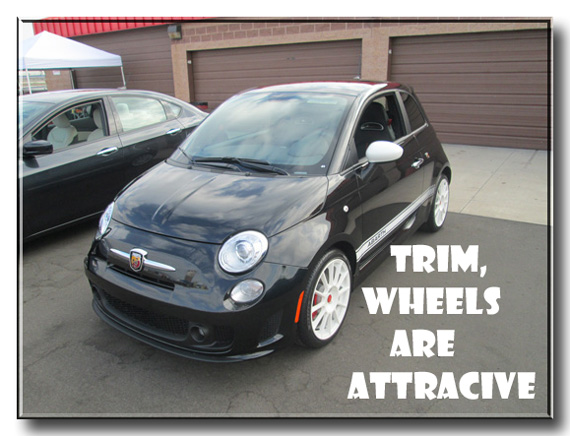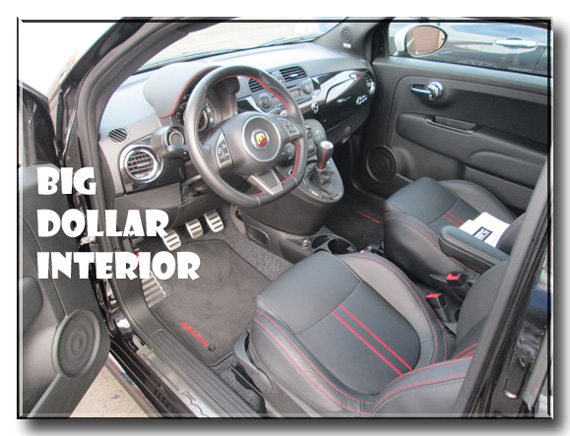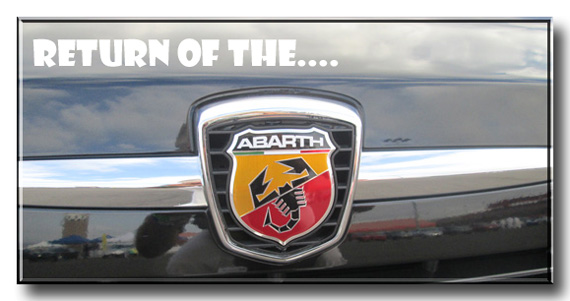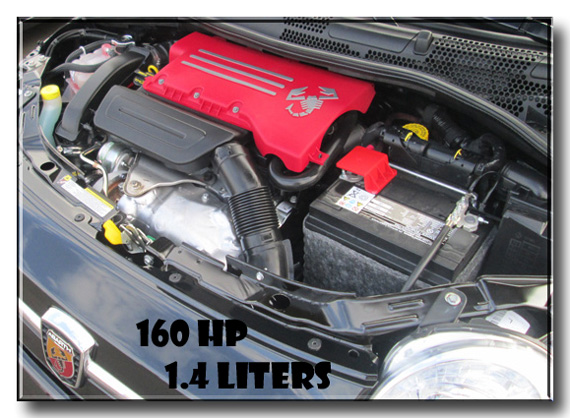By Brian Winer
A VT contributor recently drove a Fiat 500c but admitted later that the speed was lackluster because he failed to press the “Sport” button. Recently, I rectified that by not only driving a 2013 Fiat 500 Abarth hatchback, but driving the diminutive car on a race track at the limits of the tires, the car, and the driver.
The occasion was the annual Track Days sponsored by the Motor Press Guild. These track tests are a little like speed dating—five minutes to get to know each gal. You tend to like the last one you were with, until the next one. During the busy day, we also were able to test drive the Fiat Abarth’s competition so were able to get some idea of where the new Fiat stood with its peers.
The Fiat 500 is pretty damn cute as it is, sort of Mini-cute if you had to think of a phrase, recalling a model made decades earlier that was loved by many.
It has a lot of cosmetic touches on it, but the nice thing was the extra 59 horsepower which made their presence felt, taking the car from a quiet gentle tourer into the boy-racer category. The Abarth version has a track-focused suspension, and our test car had $1000 worth of wider wheels and tires, so it could grip to match the increased power.
About the Exhaust
Now Carlo Abarth, who was an Austrian, made his fortune if not name in Turin making exhausts systems which had a fine note. So we were disappointed in the new Abarth’s exhaust note. At idle it sounded mean and wicked but at speed, it was whiny, not as deep-throated (basso profoundo) as we hoped. I currently own a Ferrari 355 Berlinetta 6-speed manual, equipped with a Tubi exhaust, so maybe I am spoiled. Maybe If I owned one I’d replace the muffler with something that makes it sound more powerful at speed, to give my ears some music. Hopefully, Tubi will intro a really snarly and Italian sporty sounding exhaust system for the 500 Abarth.
We took the Abarth around both the test track at Auto Club Speedway in Fontana and through the autocross course. It was great fun, though the numbers weren’t recorded as they didn’t want the 200 journalists there racing each other.
Fiat claims 0 to 60 mph in 7.1 seconds which is a Mini Cooper S time as well.
It’s matched with the Mini Cooper S on the lateral g reading as well, close to 0.87g.
The braking distance is a few feet longer than a Mini, say one full car length.
Engine a jewel
The 1.4-liter MultiAir turbocharged four-cylinder has some neat internal goodies, like a forged crankshaft and oil squirters under each piston. The MultiAir technology is designed to allow individual control of the intake valves’ lift and timing. The car is economical…the EPA fuel economy ratings are 28 city/34 highway/31 combined mpg. Drive it hard though, and you will be lucky to see less than 23 mpg.
Going back to that Sport button on the dash, its purpose is to increase throttle response. In default mode, only 150 ft.-lb. are available and then only in 3rd, 4th and 5th gears. Punch the button and viola-170 ft.-lb. is available in every gear.
Fiat saved money by having no mechanical limited-slip differential, choosing instead to rely on individual control of the Abarth’s front brakes to redirect torque through its open differential. Fiat calls this Torque Transfer Control (TTC). Unlike a mechanical limited-slip, it doesn’t increase torque steer. Some would argue it still needs a real limited-slip differential. Since limited slip difs are mainly used to increase traction on acceleration, why have to use the brakes when you are striving for speed?
The Abarth body is not made stronger than the standard car, but the front crossmember is a stronger, cast iron version and the rear twist-beam axle is 40% stiffer. There are new bushings in the Abarth as well as 1.5 degrees of negative camber put into the front suspension. The body sits a tiny bit lower but you can feel the spring rates, which are increased 40 percent in the front and 20 percent in the rear. Koni front dampers provide two damping rates. High-frequency bumps are isolated from the chassis while low-speed inputs, like those experienced during steady-state cornering, are responded to with heavier damping effort.
The steering is quicker (15.1:1 vs. 16.3:1) and means you get that on-center precision and road feel that you need to drive with confidence. When you are in Sport Mode you get less power assistance.

Overall, we have to say that the Abarth version, except for the sound, is almost perfect. But there are so many fun to drive cars at that price level, you have to wonder why Fiat insists on such a high price. Hope springs eternal, they are going to offer a package that is similar to the Abarth but at a lower price, albeit with lower performance. It could be that they have come to realize not everybody needs an Abarth version, but desires the sporty looks and cosmetic appeal.
Value for the Money?
Our car came with 160-horsepower in a 1.4-liter turbo engine connected to a five-speed transmission. The base price was $22,700, including destination fees. But oh, Mama Mia, this car was packed, to the tune of $27,050. How did it get so high? Well, if you added up the 17″ x 7″ forged aluminum wheels ($1000), leather seats with contrasting stitching ($1000), a power sunroof ($850), the Safety and Convenience package ($750), TomTom navigation with Blue and Me ($450) and a few other minor items, that’s where you end up. It seems like a lot for a car that’s more a brief around town car, not a highway hauler that we would want to drive from California to Sun Valley, Idaho.
Part of our resistance at that price comes because at the same Track Days event, we drove the Mini Cooper two-seater coupe. which costs less and had a more gangbusters performance. The Mini has 21 more horsepower, and 7 ft.-lb. more torque than the Abarth. It weighs a little more, and is half a foot longer, but it feels like a much more solid rooted-to-the-ground car than the overly tall (for its length) Abarth.

If you wanted to drop down a bit in fashion/chic appeal, and talk Japanese cars, the Mazdaspeed 3 is cheaper by at least $1000 and can be ordered with 103 more horsepower and 110 more ft.-lb. of torque than the Abarth. But it’s a heavyweight compared to the Fiat with over 600 more pounds. We also drove the Focus ST, which was unbelievably fast, and was even larger than the Mazdaspeed 3. It lacks the Italian style, the Mini’s cuteness but damn, is it fast.
It comes down to how much of an Italian booster you want to be. I think with the Abarth, you’ve got the styling of Italy, plus historic design cues, and with the Mini you’ve got the styling of England and also beau coup historic design cues. Do you like cappuccino or a cuppa tea, m’lord? We would be 100% in love with the Abarth but in the same day, we drove half a dozen other cars that were less expensive and as much or more fun to drive.
THE AUTHOR: Brian Winer owns one Italian car, a Ferrari F355 Berlinetta, but has a penchant for small front drivers as well. He is the co-author of two books on the Ford GT.


Brian..nice fair writeup on the Abarth 500 Fiat. I have to agree that there’s more performance in some other “minis” but the Abarth has the look and chic of a real Italian car. For this type of transportation is a couple of tenths of better performance really that important? Don’t think so, so like you say it gets down to Lire spent….Let’s wait a bit and see if the price settles a bit. Peter Brock
Pretty fair report, I have about 5K miles on my Abarth and find the exhaust note fine! I have been waiting for this car since 2008- it was been worth the wait. I regret the day I sold my Abarth-Simca, so this car is a KEEPER. I even got a “thumbs up” from a mini coupe the other day!
Thanks Brian,
I have a 2012 Abarth as well as a Fiat 500 Sport and there is a big difference in power and panache. Is it worth the money for an Abarth? Heck yeah! Its the best sports car value in America; we can’t keep them in the showroom for more that a day or two.
Here’s some key differences to the Mini Cooper S:
Lighter by over 200 lbs.
Tighter turn radius.
Quicker steering.
Better CD of drag than even the JCW Mini.
Larger boot with seats up or folded plus more weight carrying capacity if needed.
Does not require premium fuel.
Better MPG numbers.
Far lower initial purchase cost.
Far lower replacement parts costs.
Far lower labor costs when out of warranty.
Far lower insurance costs.
Far more exclusivity. Want to be a instant celebrity? Buy an Abarth and stop somewhere.
Here’s the best part- For another $1000 in the aftermarket and one hour of time you can turn this car into a raging pet mouse on wheels! A $750 Marelli box (installs in 20 minutes) buys 45 more HP. Another $250 gets a cold air intake (installs in 20 minutes) for better response and the most sinister sound of any 4 cylinder. These two pieces will scare woman, children and small animals while you continue to get 35+ highway MPG.
This car will devour up any twisty back road better that anything else under $100K.
-John Montgomery – Fiat Lancia Unlimited, Benson Fiat Studio manager